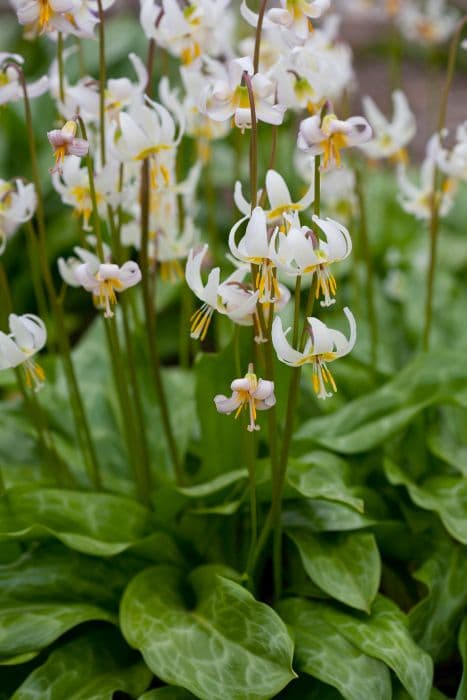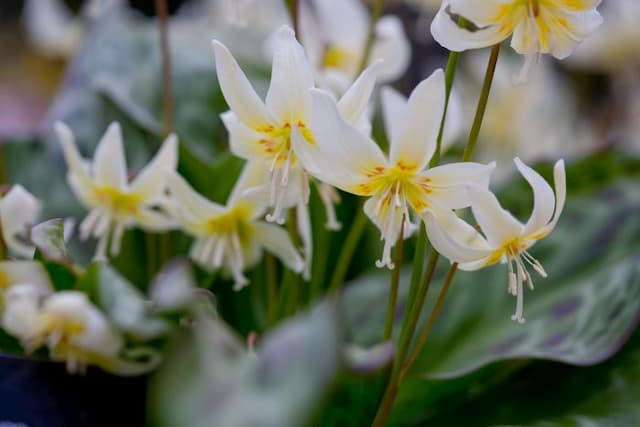Lily Lilium 'Freckled Joy' (Ia)

ABOUT
The Lilium 'Freckled Joy', also known as a type of Lily, is a captivating plant renowned for its enchanting blooms. The flowers are the most striking feature, with large, outward-facing, trumpet-shaped blossoms. The petals display a delicate creamy white base color that serves as a backdrop to a profusion of speckles and spots, typically in a rich, contrasting purple or maroon hue. These freckles add an element of playfulness and exuberance to the flower's appearance. The petals are gently curved, contributing to the overall gracefulness of the flower. Each bloom typically consists of six broad petals that spread outwards to reveal an array of these eye-catching speckles. At the center of the flower, you would find prominent anthers which carry pollen, extending outward from the base, giving the flower a sense of depth and complexity. The foliage of the Lilium 'Freckled Joy' is also worth noting. The leaves are long, narrow, and green, forming a lush background that accentuates the beauty of the blossoms. These leaves may alternate or whorl around the stem, creating a visually dynamic structure. Altogether, the Lilium 'Freckled Joy' forms a stunning visual display with its freckled flowers and verdant foliage, making it a beloved choice amongst garden enthusiasts for its ornamental appeal.
About this plant
 Names
NamesFamily
Liliaceae
Synonyms
Freckled Joy Lily, Asiatic Lily 'Freckled Joy'
Common names
Lilium 'Freckled Joy' (Ia)
 Toxicity
ToxicityTo humans
While lilies are generally not significantly toxic to humans, they can cause minor symptoms if ingested, such as nausea, vomiting, or diarrhea. Contact with the pollen might cause mild irritation to the skin or mucous membranes in sensitive individuals.
To pets
The lily is extremely toxic to cats and can cause severe kidney damage or even be fatal if ingested. Even small amounts of any part of the plant, including leaves, flowers, or pollen, can lead to symptoms such as vomiting, lethargy, loss of appetite, kidney failure, and possibly death. Immediate veterinary attention is required if ingestion is suspected. Dogs are less sensitive, but ingestion can still cause mild gastrointestinal upset.
 Characteristics
CharacteristicsLife cycle
Perennials
Foliage type
Deciduous
Color of leaves
Green
Flower color
Mixed
Height
2-3 feet (60-90 cm)
Spread
1-2 feet (30-60 cm)
Plant type
Bulb
Hardiness zones
4-9
Native area
Asia
Benefits
 General Benefits
General Benefits- Aesthetic Appeal: The vibrant flowers add color and texture to gardens and landscapes.
- Pollinator Attraction: Lilies are known to attract bees and butterflies, which are beneficial for pollination.
- Easy to Grow: They are relatively easy to cultivate and can thrive with basic care.
- Perennial Growth: As a perennial, the plant can live more than two years, providing long-term garden interest.
- Versatility: Suitable for borders, containers, and as cut flowers.
- Cultural Significance: Lilies are often associated with various symbols and meanings, enhancing their value for cultural and thematic gardens.
 Medical Properties
Medical PropertiesThis plant is not used for medical purposes.
 Air-purifying Qualities
Air-purifying QualitiesThis plant is not specifically known for air purifying qualities.
 Other Uses
Other Uses- The Tiger Lily's bulbs can be cooked and eaten as a root vegetable, similar to potatoes, but with a distinct flavor.
- Its sturdy stems can be used as natural supports for other, more delicate plants in the garden.
- The bright orange petals of the Tiger Lily can be used to create a natural dye for fabrics or artworks.
- Petals from the Tiger Lily are sometimes candied and used as decorative, edible enhancements on desserts.
- Dried Tiger Lily petals can be incorporated into homemade potpourris to add color and a soft, floral fragrance.
- The plant's seed pods can be dried and used in creating rustic and naturalistic floral arrangements or decoration.
- Given its vibrant color and unique spots, Tiger Lily flowers can be used as natural indicators for learning about pollination and the attraction of pollinators in educational settings.
- When pressed and preserved, the Tiger Lily's petals can be used in creating botanical prints or bookmarks.
- As a subject in photography and painting, the striking appearance of the Tiger Lily can inspire artists and serve as a symbol of beauty and elegance.
- The Tiger Lily can be used in the creation of natural insect repellents due to its scent, which is unattractive to certain insects.
Interesting Facts
 Feng Shui
Feng ShuiThe Lily is not used in Feng Shui practice.
 Zodiac Sign Compitability
Zodiac Sign CompitabilityThe Lily is not used in astrology practice.
 Plant Symbolism
Plant Symbolism- Purity: Lilies are often associated with purity due to their delicate and pristine appearance, and 'Freckled Joy' shares this symbolism.
- Renewal: As a type of lily, this plant signifies rebirth and renewal, referencing its ability to return each year with fresh blooms.
- Transition: The 'Freckled Joy' variety, with its unique spotting, symbolizes the idea of transition and change, suggesting growth and evolution in life.
- Hope: The bright and cheerful aspect of 'Freckled Joy' symbolizes hope, offering a sense of optimism and positivity.
- Beauty: With its unique spotted petals, 'Freckled Joy' embodies an unconventional beauty, encouraging appreciation for diversity and uniqueness.
- Motherhood: Lilies are often tied to motherhood and fertility, with 'Freckled Joy' suggesting a joyful approach to these concepts.
 Water
WaterLilies, including 'Freckled Joy', should be watered thoroughly when the top inch of soil feels dry to the touch, generally every week during their active growth period. The watering frequency might be more often during hot, dry periods or less if it's cool and rainy. When watering, soak the soil to a depth of at least 6 inches, which typically means using about a gallon of water per plant each time depending on the size of the plant and environmental conditions. Avoid overhead watering to minimize the risk of disease. Ensure good drainage as lilies do not like to sit in waterlogged soil.
 Light
LightThe 'Freckled Joy' Lily thrives in full sun to partial shade. The ideal spot for this lily would be where it receives at least six hours of direct sunlight daily. If placed in too much shade, the stems may become weak and the blooms less vigorous. However, in extremely hot areas, a location with afternoon shade can help protect the blooms and foliage from intense heat.
 Temperature
TemperatureThe 'Freckled Joy' Lily does best in a temperature range between 60 to 75 degrees Fahrenheit but can tolerate temperatures as low as 20 degrees and as high as 85 degrees Fahrenheit. It is important to protect the lilies from harsh winter conditions by mulching or bringing them indoors if they are in pots. The ideal temperature promotes healthy growth and flowering.
 Pruning
Pruning'Freckled Joy' Lilies should be pruned to remove dead or fading flowers to encourage further blooming and to prevent energy from going into seed production. After flowering, cut the stem just below the spent blooms, but leave the foliage intact to die back naturally. Prune again in late fall, trimming the stems down to the ground after the first frost has killed off the foliage.
 Cleaning
CleaningAs needed
 Soil
SoilThe Asiatic Lily 'Freckled Joy' thrives in well-drained soil enriched with organic matter; a mix of two parts loam, one part peat moss or compost, and one part sharp sand or perlite creates an ideal environment. The soil pH should range between 6.0 and 6.5.
 Repotting
RepottingAsiatic Lilies like 'Freckled Joy' typically don't require frequent repotting and can be left undisturbed for several years. Repotting every 3 to 4 years, or when the bulbs overcrowd, is sufficient.
 Humidity & Misting
Humidity & MistingAsiatic Lily 'Freckled Joy' prefers average humidity levels, around 40-60%. It doesn't require any special humidity adjustments when grown in typical home environments.
 Suitable locations
Suitable locationsIndoor
Place in bright, indirect light and ensure soil drainage.
Outdoor
Choose a sunny spot with good drainage.
Hardiness zone
4-9 USDA
 Life cycle
Life cycleLilium 'Freckled Joy,' commonly known as the Oriental Lily, starts its life cycle as a bulb, which undergoes a period of dormancy, typically during the colder months. In spring, the bulb breaks dormancy and sprouts stems, leaves, and eventually flowers, flourishing in full sun to partial shade in well-drained soil. During the summer, the plant blooms, producing large, fragrant flowers speckled with unique markings, giving rise to the 'Freckled Joy' name. After flowering, the plant focuses energy on seed production if pollination occurs, although many hybrid lilies including 'Freckled Joy' are often sterile and don't set viable seed. The lily leaves gather energy through photosynthesis during the growing season, replenishing the bulb for the next cycle. As temperatures drop in the autumn, the above-ground parts of the lily die back as the plant enters another phase of dormancy, recharging for the subsequent spring.
 Propogation
PropogationPropogation time
Spring-Early Summer
Propogation: Lilium 'Freckled Joy', often referred to as a type of Asiatic Lily, is commonly propagated through the division of its bulbs, typically in the fall after the foliage has died back. This method involves carefully digging up the lily bulbs and gently separating the smaller bulblets that form around the main bulb. These bulblets can be replanted immediately at a depth about three times their height, spaced approximately 8 to 12 inches apart to allow room for growth. This encourages the development of new lily plants that will bloom in the following seasons. It's important to ensure that the newly planted bulblets receive adequate water, particularly in the first year, to establish a strong root system.









